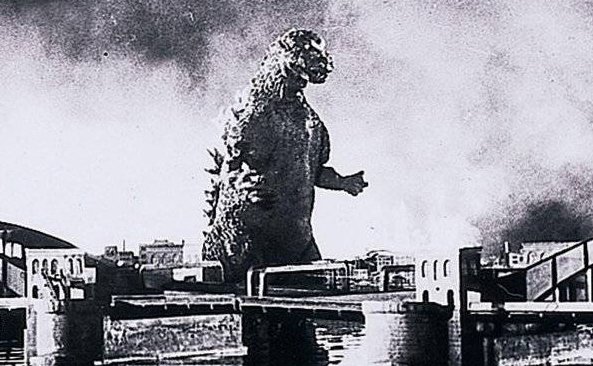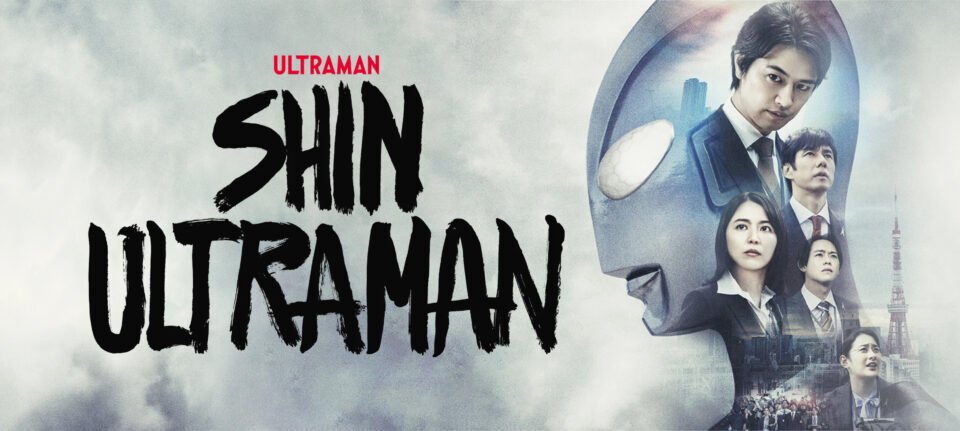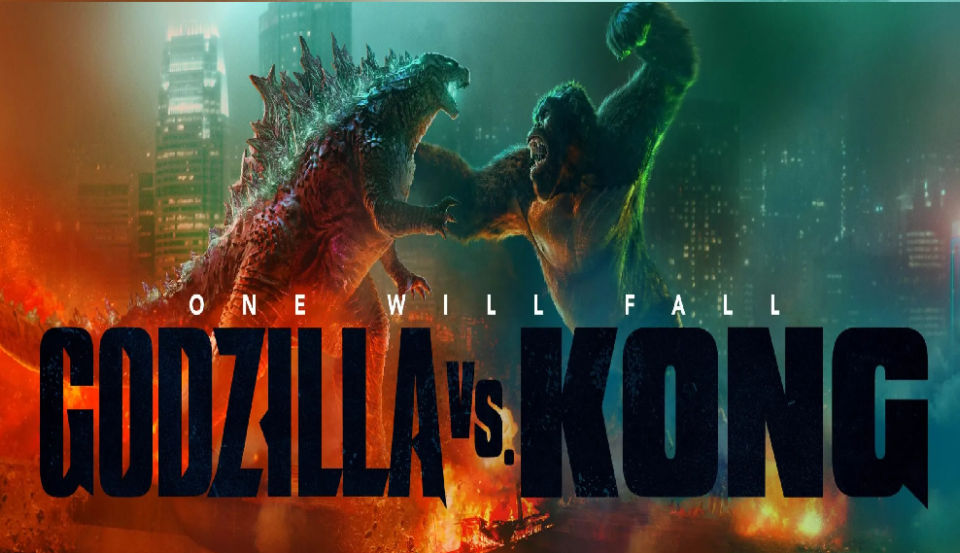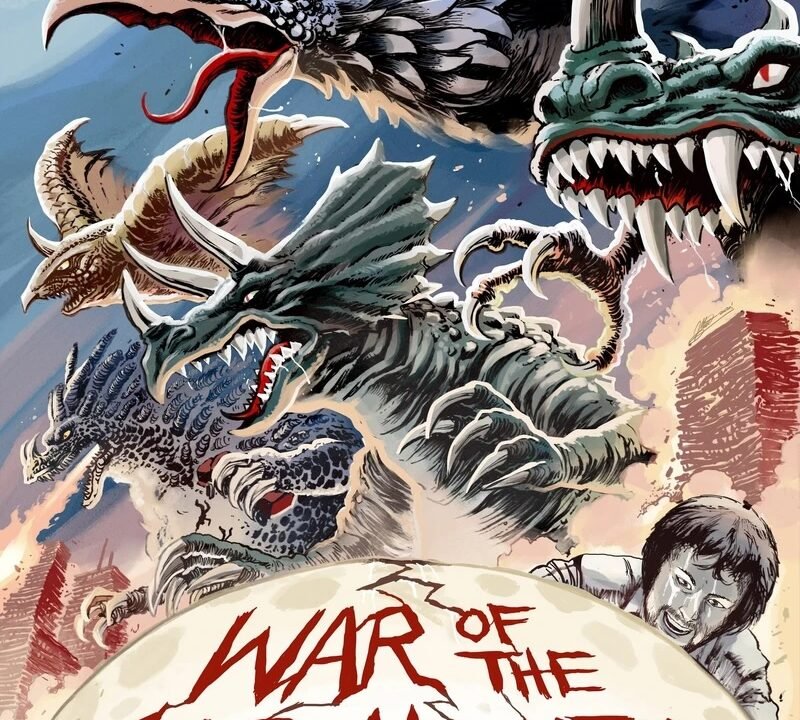
Greatest Movie EVER! Podcast Reviewing Godzilla Franchise
January 26, 2013
“Godzilla vs. Megalon” Score Review
January 29, 2013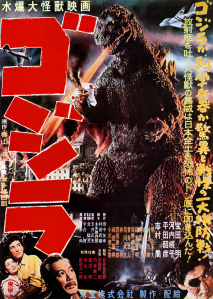 I always thought that this review would be one of the last ones I’d ever do, considering it is the film that started it all. But after getting an itch to see the film recently, I felt that it would be appropriate to write a review about it as well.
I always thought that this review would be one of the last ones I’d ever do, considering it is the film that started it all. But after getting an itch to see the film recently, I felt that it would be appropriate to write a review about it as well.
While I may mention the U.S. edit of this film, Godzilla: King of the Monsters, this review will not be a compare-contrast review. Rather, it will simply be a critical review of the original film. How does Gojira hold up for me? Read on to find out!
Synopsis: Ships are missing. Many S.O.S. reports are reporting the sea coming alive and a giant fireball igniting the vessels. Even the rescue ships don’t return from their missions.
Panic is gradually spreading throughout Japan as some fear a foreign country is, once again, declaring war on them. However, it is found out that several survivors of one of the shipwrecks floated their way to Odo Island. Dr. Yamane, his daughter, Emiko, and Ogata, head for the island to pick up the survivors and to investigate the island, because it has been known for a giant creature to occasionally appear on the island.
Once there, a giant creature attacks during a severe storm, laying waste to most of a village. Dr. Yamane and his staff find traces of Strontium-90 and everyone, later on, witnesses the sight of the beast the Odo Islanders call Gojira.
Back in Tokyo, Dr. Yamane presents his findings to the government and the government begins to erect defense measures in case Gojira should ever attack Tokyo. Dr. Yamane, however, wishes for the creature to be studied and not destroyed.
Meanwhile, Emiko, Ogata, and Dr. Serizawa are caught in a love triangle. There is an arranged marriage between Serizawa and Emiko, but Emiko loves Ogata instead of Serizawa. Ogata pleads with Emiko to break the news to Serizawa, but Serizawa is under duress when a reporter asks him about a special weapon he may be developing that could help rid the world of Gojira. Serizawa denies such claims and, once the reporter leaves, shows Emiko his Oxygen Destroyer; a weapon that asphyxiates any living creature within a particular radius of the device. Horrified at what she has witnessed, Emiko heads home and admits to Ogata that she did not tell Serizawa of her love for Ogata.
Gojira makes landfall in Tokyo Bay and makes quick damage of a train depot before heading back into the bay. Tokyo is put in a panic, realizing that the kaiju, more than likely, will return. A large barbed wire fence is constructed with thousands of volts of electricity running through it. Much of the city is evacuated as well in preparation for a second probable appearance by Gojira.
Gojira doesn’t disappoint. He arrives and isn’t fazed by the massive electrical fence. The Japanese Self-Defense Force open fires, but this, too, is ineffective. Gojira is loose on Tokyo and there is nothing that can stop him. Much of Tokyo is now in ruins.
Emiko discloses Serizawa’s Oxygen Destroyer secret to Ogata. Terrified after witnessing the destruction of Tokyo, Ogata visits Serizawa in the hopes he will use his weapon to destroy Gojira. At first, Serizawa refuses, but after a quick skirmish with Ogata, and witnessing the casualties on television, Serizawa gives in and destroys his notes for fear that such a weapon could be produced and used on mankind. It is also at this time that Serizawa realizes Emiko loves Ogata and his arranged marriage with Emiko is over.
Ogata and Serizawa dive into the bottom of Tokyo Bay with the Oxygen Destroyer. There, they come face-to-face with Gojira. The two men make 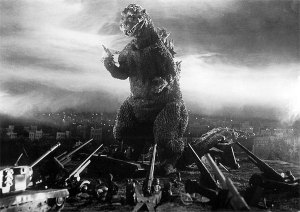 preparations to drop the weapon next to Gojira. But, before doing so, Serizawa has Ogata taken to the surface. After dropping the weapon next to Gojira, Serizawa sacrifices himself. He fears that, if alive, he could be kidnapped and interrogated on how to build the Oxygen Destroyer again.
preparations to drop the weapon next to Gojira. But, before doing so, Serizawa has Ogata taken to the surface. After dropping the weapon next to Gojira, Serizawa sacrifices himself. He fears that, if alive, he could be kidnapped and interrogated on how to build the Oxygen Destroyer again.
Gojira bellows in agony at the surface before falling into a pile of bones at the bottom of Tokyo Bay. Gojira is vanquished.
Story: We get a magnificently told story with this film! Kayama and Murata did a wonderful job in capturing the horrors of the aftermath of Hiroshima and Nagasaki; along with the psyche of the Japanese people. The threat of another nuclear weapon being used against the Japanese people is a fear that’s seen throughout much of the earlier part of the film.
The pacing of the film is slower than that of the U.S. edit, but that’s not to say it’s a detriment to the film. In fact, this is probably the best characterization we get out of the entire Godzilla franchise. The U.S. edit uses a lot of exposition to explain what’s going on with many of the Japanese characters, only because that version edited out much of the areas of the film that were devoted to character development.
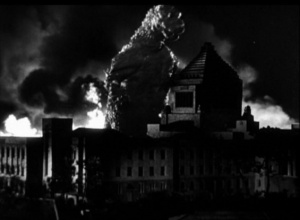 The tone of the film is very depressing. Even after nearly 60 years, the viewer can still feel the fear that was in the hearts of the Japanese even nine years after the second World War. There is a haunting scene, during Godzilla’s second rampage on Tokyo, where a mother is holding her two children and she is telling them that they all will join their father soon. Then Godzilla blasts his ray at them. While some of the horror elements may not be quite as powerful today as they were then (and this is most likely due to the amount of time having past), there are chilling scenes and this was a project that most likely was risky in showing some of those horror elements during the mid-1950s.
The tone of the film is very depressing. Even after nearly 60 years, the viewer can still feel the fear that was in the hearts of the Japanese even nine years after the second World War. There is a haunting scene, during Godzilla’s second rampage on Tokyo, where a mother is holding her two children and she is telling them that they all will join their father soon. Then Godzilla blasts his ray at them. While some of the horror elements may not be quite as powerful today as they were then (and this is most likely due to the amount of time having past), there are chilling scenes and this was a project that most likely was risky in showing some of those horror elements during the mid-1950s.
Gojira provides a terrific story that gives the viewer characters they can connect with. The theme of nuclear warfare is still a bit chilling even by today’s standards. Godzilla’s rampage across Tokyo gives horror elements that still work today even if the techniques used in 1954 are not as realistic/effective as they are today.
Special Effects: Despite the movie’s tight budget (although not as tight as Godzilla Raids Again) the special effects are great and many still hold up well today. Eiji Tsuburaya’s team did a magnificent job with the construction of the Godzilla suit and the miniature sets. Heck, they even made city blocks exactly as they were in 1954 Tokyo.
The only drawback to the effects is the Godzilla hand puppet. The arms are stiff, the eyes don’t match up with the suit’s eyes, and the mouth moves awkwardly due to the puppeteer’s hand motions in order to make the kaiju roar. Of course, this was probably all they could afford, and do, during the production of this movie.
Acting: In my opinion, we get one of the best casts in any Godzilla movie with Gojira. All of the actors (Takarada, Kochi, Shimura, Hirata, etc.) do a 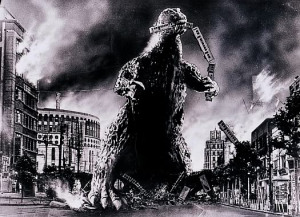 fantastic job! The love triangle takes center stage in the film as Kochi, Hirata, and Takarada play their parts well when they are either concerned, excited, etc.
fantastic job! The love triangle takes center stage in the film as Kochi, Hirata, and Takarada play their parts well when they are either concerned, excited, etc.
Even the very small parts, played by many of the extras, are done really well. Again, I have to go back to that scene of the mother huddling up with her two kids on the burning streets of Tokyo before Godzilla is about to blast them.
I don’t think you can get better acting in any Godzilla film than this one!
Battles: Considering that it’s a solo Godzilla film, the battles are not going to be quite as exciting than when he has a foe. Some of the conflict presented in the film is very minute; and that’s more than likely due to the budget. We get some military officials firing automatics at Gojira and a few miniature tanks firing on Nakajima and Tezuka.
Of course, unlike the many sequels that came after this film, the battles were not the heart and soul of the movie. The theme of nuclear warfare took center stage. The movie’s drawback comes from a lack of fast-paced, high-octane battles. Once again, this was not the film’s main purpose. Nevertheless, I have to rate it…
Human Drama: Like I had mentioned in the Acting section above, we have terrific characters in this movie! The love triangle, of course, is the center of the drama in this film (outside of Godzilla).
 The characters are so well fleshed-out that you really can understand their motives. Dr. Yamane wanting to keeping Godzilla alive to study him; Dr. Serizawa’s insistence on keeping the Oxygen Destroyer a secret then not wanting to use it; Emiko’s consistently being torn by the motives of her fiance and the man whom she is arranged to be married to. It’s all done fantastically well!
The characters are so well fleshed-out that you really can understand their motives. Dr. Yamane wanting to keeping Godzilla alive to study him; Dr. Serizawa’s insistence on keeping the Oxygen Destroyer a secret then not wanting to use it; Emiko’s consistently being torn by the motives of her fiance and the man whom she is arranged to be married to. It’s all done fantastically well!
Overall: Forget my rating in the Battles section, because that shouldn’t deter you from seeing Gojira if you haven’t done so already. The film, yes, is more slower paced than many of the other Godzilla films and may not contain the amount of excitement either.
But the film is a piece of cinema history. After The Seven Samurai, Gojira is considered to be the best Japanese film of all time. The nuclear allegory of Godzilla and many of the fears following World War II still linger here.
The human drama is done very well and you’ll be surprised as to how much you get caught-up in it even if you don’t typically go for those sorts of story devices. Godzilla’s rampage on Tokyo is executed well, but will not be terribly exciting. Rather, I find myself immersed in the horror this rampage delivers and it is extremely haunting.
Every Godzilla fan needs to see Gojira. Heck, even non-Godzilla fans need to see this film in order to, a certain degree, understand the terror many Japanese still felt nearly a decade after the war and to see what Godzilla truly stands for.


